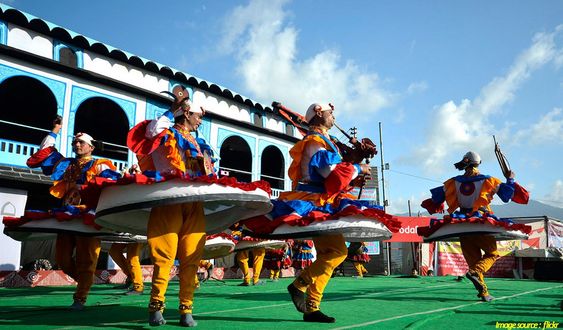The Chholiya, originating from the warring Kshatriyas of Kumaon, dates back over a thousand years when marriages were solemnised at sword-point. United by the Chand Kings in the 10th century, native Kshatriyas were influenced by immigrant Rajputs, who adopted hill customs and shaped Pahari culture. Though the era of sword-point marriages ended, the traditions persisted. Hence, the groom in Kumaon is still referred to as Kunwar or King, riding a horse in the marriage procession and carrying a ‘Khukri’ in his belt.
Chholiya is one of the primary folk dances of the Kumaon region of Uttarakhand. It is a performative depiction of a sword fight, accompanied by folk songs sung in the tunes of Hudaki and Mashakbeen (bagpiper).
The term 'Chholiya' comes from the word 'Chhaliya', which means someone who deceives or tricks others. It is very similar to martial arts, where deception is used to trick opponents before attacking them. Chholiya, as an art form, blends dance and martial arts. It's a type of performative duelling involving fighting and fencing with each other, as well as protecting oneself with a shield.

The performers of this art form are known as Chhaliyas, typically hailing from the lower strata of society. The dance is executed in groups comprising 22 members. Among them, 8 are Chhaliyas who engage in both dancing and sword fighting. Additionally, one performer adopts cross-dressing to portray a female role, as women are traditionally barred from participating in Chholiya performances. The remaining 14 members constitute the musical ensemble, known as Dholi aur Das, playing instruments such as the Bagpiper, Dhol, Damau, and Hudaki.
Narendra Prasad, a Chhaliya from Pithoragarh, said, "Earlier, the Chholiya performers used to lead the army in the battlefield. The purpose of them accompanying the army was to motivate them on the battlefield. Later on, this practice got adopted in Chholiyas leading a marriage procession and now they are called to perform on every auspicious occasion."
According to Dr. Lokesh Ohri, an author and anthropologist, "In 1815, when the Anglo-Gorkha War began, the British had already taken control of India. But they were very afraid of the Himalayas because they feared the mountains. Yet, during the Anglo-Gurkha War in 1815 and 1816, they saw how brave the Gorkha and Pahadi soldiers were. They realised that these soldiers could also fight for them in this region."
They constituted a battalion in their army with these pahadi soldiers. Along with the battalion came its parade, and how can you have a parade without a band? They also realised that the warriors from Garhwal and Kumaon were not only good, strong, and athletic fighters but also musically talented.
So the British trained them to play musical instruments. There were a few Scottish units in the British Army, and these units were always on the move. Even today, there are several Gurkha soldiers and a Gurkha Brigade in the British Army. So, the soldiers were also asked to participate in the army bands, and they were trained to play the Scottish bagpipe.
Chholiya is more than just a folk dance for its people. It is attached with the local belief of the pahadi people. They believe that auspicious occasions like marriage or childbirth are vulnerable to negative spirits, thus a Chholiya performance can help prevent any harm. It is a testament to the history of the hills, and signifies the valour of the warriors that lived in here.
(Shashank Bhatt is a content writer)
Banner Image: Wikipedia